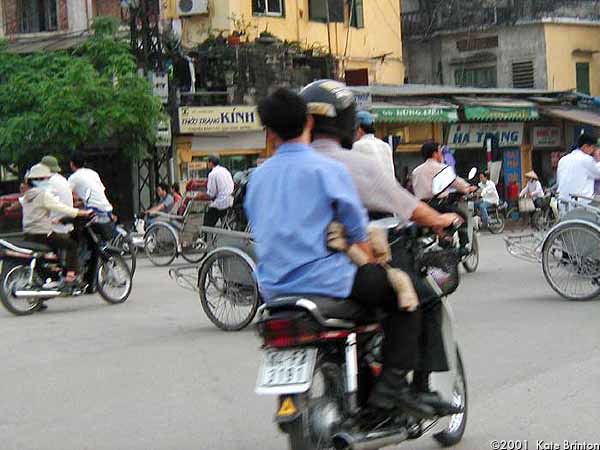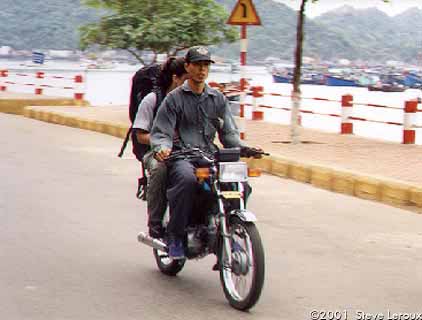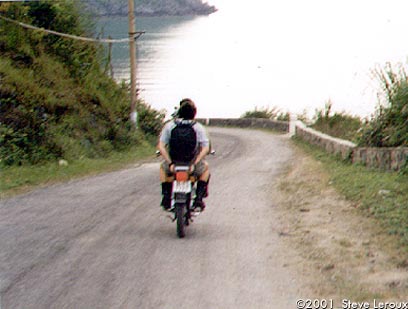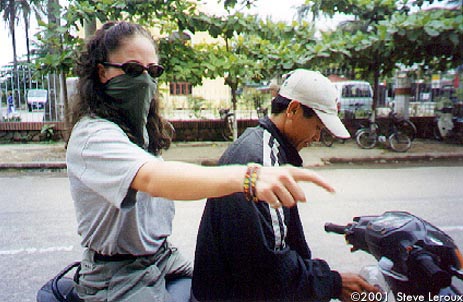Planes, Trains, and Automobiles (...and Motorbikes, and Cyclos...)
I'd like to write a bit more about the transportation and traffic in Vietnam because I found it very interesting. First, the traffic:The only discernible "rule" of the road is that people tend to drive on the right (although not always). Other than that, traffic moves in an anarchic swarm with hardly any traffic signals or other signs to provide direction. Motorbikes are the most prevalent, followed by cyclos (same as becaks) and pedestrians, with cars and trucks being the least common. When passing someone, drivers honk to announce their presence. The more compulsive drivers, especially in Hanoi, honk frequently and vigorously. But after observing for a while, I've noticed it is only a noisy few who honk all the time. The other drivers only honk when necessary. Intersections, even large ones, are usually free-flowing, with vehicles hardly slowing before proceeding through in all directions.

What makes all this work is a completely different attitude toward driving than I'm used to at home. At home, there are many laws of the road, and everybody knows them, which can give a driver a sense of moral superiority. When someone cuts off my hypothetical driver, he or she feels justified in being angry because they are in the right, and the other person is clearly breaking the law.
In Vietnam, there are not very many traffic laws, at least not that are enforced. This means that nobody steps up onto that moral high horse, and everyone is careful to avoid each other. Everyone yields. In all my time here, I never saw one incident of road rage, not even a cross word, even when people almost collided. And everyone is on equal footing. Cars don't "own the road;" bicycles and pedestrians have just as much right to be anywhere on the road (not just right by the edge). Only the largest of trucks really force anyone to the side, and that's often necessary because of narrow roads. As pedestrians, Steve and I plunge out into traffic and walk steadily across the street while scooters and bikes just go around us.
It can be frightening at first, but by now I understand how it works and have really come to enjoy this system. I feel more welcome on the road here, and I can be sure that other drivers not only see me (because everyone is paying attention), but will yield to me as well if necessary.
~ * ~ TRAINS
Before Vietnam, my train travel had been limited to subways in a few cities. I had always wanted to take a real train trip, and here I've had the chance to take a few.
Trains in Vietnam have several classes:
There are some other variations, but those are the basics. The first two are just how they sound. Hard berth means you sleep in a compartment that has six berths: three to a side. They truly are hard, usually just wood, although sometimes there is a tiny bit of padding. The top berths are cheaper because they're too close to the top of the car to sit up. The bottom berths are the best because there is a storage space underneath, and when you're sleeping on top of it, nobody can open it. In soft berth class, there are only four berths to a compartment, and they are not only padded but you are given bedding. Super soft berth is the same, but with air-conditioning.
Hard seat
Soft seat
Hard berth
Soft berth
Super soft berth
We got to experience all of the berth classes on this trip, since we travelled solely on night trains. First, we travelled hard berth to Sa Pa because the trains didn't have anything better. They were predictably pretty uncomfortable. On the way up, we got a bit of padding, but on the way back, there was none and we had a lot of trouble sleeping. Also, having six people in a compartment makes it a bit crowded. During the day and evening (before retiring for bed), everyone sits on the bottom bunk. On the way back from Sa Pa, we had seven people in our compartment because a woman and her child shared a bunk.
All the same, it was fun to travel on a train, so we booked another night train from Hue to Nha Trang. We ignored the advice of our guidebook to book trains a couple days in advance, so the only thing we could get was super soft berth (more expensive than we would have chosen). But we were lucky to get on the train - getting the tickets involved a very nice train station employee who pulled some strings for us and received some cigarettes from us in exchange for his help.(We have been carrying around packs of cigarettes because we thought we might need them for bribes.)
The super soft berth was a very nice ride. Having four people in a compartment was a reasonable number, and to our surprise we were served a decent (though mostly unidentifiable) dinner. Sleeping in the soft berths were wonderful - all night we were rocked by the motion of the train.
Our last train ride was the night train from Nha Trang to Saigon. Again, we booked at the last minute, and the only tickets available were on the SN1 train, a train that was several hours slower than the others. But we didn't think the extra time would be a problem since we'd be asleep anyway, so we bought soft berth tickets for the slow train.
We found out later why the train was so slow. Not only was it an older train, so it moved a little slower, but because of this, it often had to pull aside and wait for the faster trains to pass by. Most of the extra travel time was spent parked in the middle of nowhere, waiting for the whistle of the fast train.
The windows in the hallway of our train car were left open, which meant that all kinds of bugs were forcibly blown into our compartment. Eventually, we closed up the compartment doors and windows, which fixed the problem, but not before some unpleasant encounters with a large beetle and some aphids and dragonflies. It was also rather hot since we didn't have air-con, but as the night progressed, it finally cooled down. I had my doubts about getting any sleep when we were hot and buggy, but eventually, we both slept well. Again, the motion of the train was very soothing.
I only wish train travel at home was more affordable.
~ * ~ MOTORBIKES
I should start this section by saying that I had a motorcycle at home, so I'm familiar with riding motorbikes. However, it didn't really prepare me for the experience in Vietnam.
First, there is the traffic to contend with, and the poorer condition of the roads. Then, of course, nobody wears helmets. Scooters are often a family's main or only means of transport, so it is not unusual to see three or four people crowded onto a single bike (I've seen up to five). Or, motorbikes can be fantastically loaded with any kind of cargo you could dream up.
Steve and I pretty much assumed we would avoid this method of transport because it looked too risky. But, as it turned out, the choice was not ours. On our tour to Ha Long Bay, we arrived at a boat terminal and needed to get into town with our luggage. The tour had arranged for everyone to be carried on the back of a motorbike. I kept asking, "but what about our bags?" and refused to believe that there were no provisions made. But it was true - we were expected to carry our luggage on the motorbike along with ourselves and the driver!
At this point, I was nothing short of terrified. Since I know how to ride motorcycles, I know how the balance works. I knew that my driver had no idea how heavy my backpack (still strapped to my back) was. So he would not be able to take it into consideration when judging turns. But there was no other way to get into town - unless I wanted to walk, alone. So I sat on the back of the bike and held on for dear life.

Me, terrified, with full pack
Me, with only my daypack
Obviously, we didn't have an accident or you would have heard about it by now. But every moment of the ride was harrowing and I was furious at the tour operators (who were otherwise pretty good) for the arrangement. Later, we rode to and from the boat landing on the motorbikes again, but this time with only our daypacks on. That was a much better ride. But the dreaded moment came when we had to return to the boat with our bags. This time, I wanted to make sure my driver was aware of the weight of my bag, so I gave it to him to hold in the front of the bike. As expected, he found it pretty unwieldy, and drove carefully. I was still pretty scared, and quite relieved to arrive in one piece.In Hue (a town I haven't mentioned much, which wasn't terribly interesting), the main tourist attraction is a boat trip which everyone tries to sell you. Mindful as always to avoiding the tourist traps, we looked around for other options and found a cafe offering motorbike tours. Their guestbooks were full of raves from previous customers, so we signed up. No heavy luggage this time - so I was only a little nervous. I donned a bandanna and sunglasses to protect myself from the dust in the air, and we set off.

This was a much better experience from the riding perspective. Our drivers were exceedingly careful and drove very safely. At first, I was watching the road (often a muddy trail) as carefully as if I had been driving. But eventually, I relaxed and could enjoy the scenery. The tour itself was mediocre, as we were hauled from one tourist spot to another, and told to return to the entrance at a certain time. In fact, my favorite part of the trip was sailing through rice paddies on the back of a bike.
Our final motorbike experience was a tour we took around Nha Trang that I will describe more later. On this ride, we had one careful driver and one who was a little more reckless, which meant that one of us was always being left far behind the other. When I rode with the faster driver, we went around a few curves faster than I was comfortable with, but again we were fortunate and arrived safely.
Travel has changed me in many ways. One of them is that I have learned to relax and hop on the back of a motorbike and trust the driver's experience.
